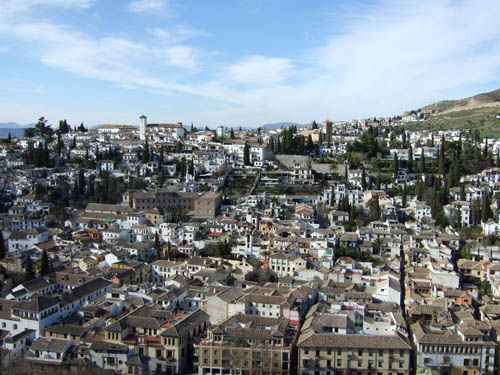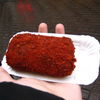The Majesty of Southern Spain
Brittany Henshue
Andalusia boasts the most tourist-friendly cities and picturesque vistas of Spanish coastline along with some of the better-known landmarks and spots of historical significance in the country. Known for the birth of bullfighting, flamenco, tapas and the guitar this southern region of Spain is a must-see tourist destination that will leave you in love with Spain, its traditions and its people. The main cities to visit are Seville and Granada, each contains its own unique sights and offers visitors distinctly different views on Spanish culture.
If you want to have a complete Andalusian experience I would recommend renting a car. Although the precarious Spanish highway system does take some getting used to, it is by far the cheapest way to cover a lot of ground in a short period of time. Plus the long winding highways provide awesome views of the endless olive groves, charming mountain towns, expansive untamed countryside and the Mediterranean Sea that make up so much of the face of Spain. Within the major cities most destinations can be reached on foot or by bus, and there are regular trains between major destinations as well.
Granada is most famously home to the Alhambra, quite possibly the world's most famous mosque. One of the last untainted remains from the medieval Islamic Spain this combination mosque, palace, botanical gardens and harem is by far Spain's most well-known attraction and is petitioning to be called "the eighth wonder of the world". Its majestic atmosphere leaves sightseers in a quiet hush over which only the sweet song of the birds and constant trickling of the many man-made streams and waterfalls that twist and wind their way through the Alhambra can be heard. It is Spanish history at its finest and definitely merits an entire day of undivided attention. Perched atop a small mountain it provides breathtaking views of the Granada and leaves you marveling at the decadence and splendor of empires long dead.
Other important things to see in this vibrant city are the cathedral, which houses ancient religious relics, and more importantly, a traditional flamenco show. Flamenco dancing originated in this part of Spain, and here you can view shows the way they were originally performed, in a long whitewashed cave, burrowed into the mountainside, with a drink in hand. These dancers come from old families who pass this ancient tradition of dance down from one generation to the next and will sweep you up in the fervor and passion of the dance and leave you breathless and amazed, wishing you were capable of doing anything with as much conviction and dignity as these Spaniards dance.
Seville's chief attraction is its bullring. As the oldest standing bullring in the country it is also the only oval shaped one. The attached museum provides an informational history of the sport as well as its traditions in Spanish culture. If you are there during the season (between April and September) and wish to see a fight be sure to purchase tickets in advance, but I warn you, this is one sport that is not for the faint of heart. Be prepared to see some pretty graphic stuff I definitely would not recommend taking young children.
Seville also has a breathtaking cathedral, as do most major Spanish cities. But if you only have time for one more stop, I would recommend the Plaza de Espana. This open-air plaza is situated at the edge of a great park and contains tiny tiled alcoves for each of Spain's main provinces. The stately buildings surrounding the half-circle of the plaza are mostly for government use, but make quite the beautiful backdrop for this historical attraction. Vendors in the plaza sell everything from key chains to ice cream and it is the perfect place to rest, people watch, and take in some ancient architecture simultaneously.
A word of caution, southern Spain is a wonderful place for tourists, which makes it also a wonderful place for people to try and take advantage of them. Be constantly aware of your surroundings and keep belongings close at all times, pick-pocketing is common, but can often be prevented by simply paying attention. Also, watch out for the gitanos, or Spanish gypsies. They will try to swindle tourists and are stubborn and hard to avoid. It is best to steer clear of making contact with these people and definitely never take anything that they hand to you, even if the say it is a gift, they will try and charge you for it.
Amidst the bustling metropolitan cities of Cordoba, Seville, Cadiz and Granada small-whitewashed stucco towns can be found nestled in the valleys of the Sierra Navada Mountains and cuddled up to the coastline of the Mediterranean Sea. These towns and villages offer a quiet respite for the weary traveler looking to escape the hustle and bustle of the bigger cities, especially during tourist season. Each town features its own set of small-scale attractions, each of which have their own merit, but if you have the time to take in one of these quaint Spanish towns I would recommend spending time at a street side cafe, sampling the local fare, and people watching. You will find no more genuine Spanish food, drinks, artifacts and traditional lifestyles anywhere. Personally, I would recommend the town of Ronda, but any one of these less active towns will provide tourists with the same sleepy atmosphere and peaceful glimpse of a day in the life of a true Spaniard.
Featured Articles
If you are looking to sum up Barcelona in one word, in a city as large and eclectic as this Spanish gem, it is possible: colorful.
From multi-tier cakes to underground record shops, truly neighborhood restaurants (where English might not be on the menu) and where to rent a bike that won't make you look like a tourist - this guide brings you seven fairly hidden - and absolutely delightful spots in Amsterdam for those looking for something different.
Ireland’s capital offers plenty to see in its own right, but the chance to get away and take a look at some of the trademark greenery of the emerald isle shouldn’t be missed.
High on the list of day trips is Karlovy Vary, a town located near the German border in what is considered the Bohemia area of the Czech Republic
When you think of the Netherlands, “culinary expertise” is not a phrase that comes to mind.
Free Backpacking Europe Planning & Essentials Guide
Download/More info on the Backpacking Planning and Essentials Guide
Featured Articles
If you are looking to sum up Barcelona in one word, in a city as large and eclectic as this Spanish gem, it is possible: colorful.
From multi-tier cakes to underground record shops, truly neighborhood restaurants (where English might not be on the menu) and where to rent a bike that won't make you look like a tourist - this guide brings you seven fairly hidden - and absolutely delightful spots in Amsterdam for those looking for something different.
Ireland’s capital offers plenty to see in its own right, but the chance to get away and take a look at some of the trademark greenery of the emerald isle shouldn’t be missed.
High on the list of day trips is Karlovy Vary, a town located near the German border in what is considered the Bohemia area of the Czech Republic
When you think of the Netherlands, “culinary expertise” is not a phrase that comes to mind.
Free Backpacking Europe Planning & Essentials Guide
Download/More info on the Backpacking Planning and Essentials Guide




